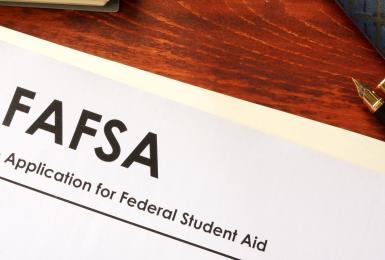As has been widely discussed in the media, college tuition has risen dramatically in recent years, with statistics showing that the cost of higher education has more than doubled since 1986. This has created significant challenges for prospective students, whether they're 17-year-olds getting ready to go to college for the first time, or adult learners considering returning to school after years away.
As they explore their higher education options, many prospective students have questions about the rising tuition costs. What's causing this rise, and how can they find workable solutions to help them pay for their education?
While the answers to these questions are complex, there are a few factors to take into consideration.
Why Is College Tuition Rising?
Economic Trends
One of the biggest factors affecting college tuition is the overall economic climate. Post-recession, states have simply had less money to work with. CNBC, citing a 2015 Moody's report, says that "Mandatory spending programs, specifically Medicaid, are requiring more and more state funds, which in the zero-sum world of state spending, has left fewer and fewer dollars for other programs." As a result, public funding for higher education has reached historic lows, and tuition has risen across the board to offset that loss.
Furthermore, many institutions' endowments were hit hard by the recession, and while some have recovered, many haven't - meaning that revenue is primarily derived from tuition.
Simply put, many institutions need to increase tuition to continue operating as they have been. This has created a significant wealth gap in the higher education world, with the top 40 richest schools in the country receiving nearly 60% of all gift revenue. This means that most institutions don't have the funds available to subsidize tuition for their students to the extent that they have in the past, and must pass the cost of a degree along to their students as a result.
It's Taking Students Longer to Graduate
While undergraduate degree programs are often referred to as "four-year" programs, the reality is that many - if not most - students end up taking longer than four years to complete their degrees. In fact, research shows that the average four-year college only graduates around 55% of its students in that time frame!
For some students, this extra time represents one or two semesters, but for many others, it could be significantly more. This is especially true for adult learners, many of whom have stopped and started a number of degree programs over long periods of time. Once these individuals pick a degree program that they want to follow through to completion, they have often accrued a large number of credits (which aren't always applicable to their new degree program, and have already cost them quite a bit of money).
It stands to reason, then, that the more time spent in a degree program, the more courses one has taken (or must take) - and the more credit hours one has to pay for.
The Traditional Campus Experience Costs More
When people think of going to college, they typically have an image of a traditional college experience in mind: a quad filled with students, dorms and dining halls, big brick academic buildings filled with faculty offices and classrooms, and sports teams to cheer for. And this experience is the reality for many students - but it comes at a cost. Offering these programs, operating buildings, providing housing and food for a large student body, and maintaining the onsite staff needed to support students in all areas - including academics, health, and community wellbeing - requires a significant amount of overhead, and is therefore expensive. And typically, that cost will be reflected in students' tuition rates - so as schools offer more amenities and programs to compete with other institutions, tuition will rise to reflect those additional operating costs.
For an 18-year-old heading off to college for the first time, these elements might feel like an essential component of the college experience - and it's true that younger students often need the structure and support to help guide them through their time at an institution. While academics should be, of course, the priority when it comes to deciding on a college, the importance of these added benefits shouldn't be discounted.
However, there are many students who can't or don't want to take on the financial burden of a typical four-year college tuition, and still others who simply aren't looking for that traditional experience. For these students, lower-cost options do exist, from community colleges to online degree programs. Online learning is particularly valuable for these students, as you'll get a high-quality education at a much lower cost due to the lower overhead needed to operate these programs.
Sticker Price Is Often Much Higher Than Tuition Paid
Most schools advertise their tuition rates at what's known as the "sticker price" - the full cost of tuition for someone paying 100% out of pocket with no aid, discounts, or scholarships. The vast majority of students end up paying much less than this amount. For example, at private four-year colleges, the average sticker price is $36,801, but the net price - what the average student ends up paying to attend - is usually much lower. While it is still a significant financial investment, it's one that's more in line with what many students can reasonably afford (or can cover with federal student loans).
Net price calculators are widely available online, and some ranking websites, like U.S. News & World Report, also list average net price alongside a school's official tuition, to help students have a better picture of what they'd actually be spending to attend.
Fees Add Up
Unfortunately, tuition is just one piece of the financial puzzle at many institutions. Many students find themselves bombarded with additional fees on top of their tuition - and while these amounts can seem small, they add up quickly, and can result in owing the school significantly more money than anticipated. These fees are generally not advertised upfront, and can be charged for a variety of things - orientation fees, commencement fees, textbook fees, lab fees, library fees, parking fees, tech fees and more. Even some online degree programs charge similar fees for access and technology.
To avoid unwanted surprises, be sure to ask the financial aid office upfront about any fees you might need to expect, or look for schools that are transparent with their cost breakdown to help you ensure you can afford the education you're signing up for.
While college tuition might be rising - and seem more expensive than ever - there are still many options out there for savvy education shoppers.
You May Also Like
Request Information
Connect with our admissions team to learn more about Champlain College Online.

Request Information
I acknowledge that, by clicking the "submit" button, I am giving my express written consent to Champlain College and its representatives to contact me about educational opportunities via email, text, or phone, at the phone number above, including my mobile phone, using an automatic dialer, or pre-recorded message. Message and data rates may apply. I understand that my consent is not a requirement for enrollment, and I may withdraw my consent at any time.






